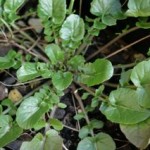This wild edible receives the most comment on my blog from absolute delight to abject hate. I can understand both sides of the issue, although I happen to love it. My Dad however, would take the opposite stand calling it ‘Marching soldier’ derived from ‘gallant soldier’ derived from galinsoga parviflora It’s spreading nature earned it the ‘marching ‘and ‘gallant’ additions to its nick names.
Leafy and upright, this summer annual reaching 75cm, maybe maligned as an invasive weed, yet it’s valued as a potherb in some parts of the world. I find it a pretty plant, with its pointed and toothed yellowish-green oval leaves. The leaves are in opposite pairs and the leaf margins and stems are hairy. It has clusters of small flowers with yellow centres and five white petals, each three-lobed at the tip. Flowering from October through April, it likes to grow amongst your vegetables and flowers, in cultivated land, and in pasture and waste places, in sun and partial shade. It’s named after an 18th century Spanish physician, and parviflora is Latin for small flowers.
Galinsoga isn’t common all over New Zealand yet, but once you have it in the garden it’s usually there to stay. It’s native to South America and known as guascas in Colombia, where it’s an essential ingredient in ajiaco, a Bogotá chicken and potato stew or soup. I’m thrilled to have just made this delicious stew. I was sent the recipe by a man living in the Channel Islands who ordered some seed. He wants to make the recipe for a Colombian friend and couldn’t locate seeds.
I prefer to use leaves of young plants, before the stems become tough, and also the flowers, in smoothies,
salads, stews, steamed, or juiced and mixed with other juices. I cut the young plants at ground level and use them to make a delicious salad or in smoothies. While waiting for my vegetables to grow and mature, I am harvesting food.
Flowers and leaves are both mild in flavour and can be dried for winter use. Galinsoga is another remedy, along with plantain and dock, for neutralising the sting of nettles. It is astringent in its action and can be used to help clot the blood of cuts and wounds.
Surprisingly 100 g of galinsoga contain 3.2 g protein and 1.1 g of fibre (compared to spinach, with 2.9 g
protein and 2.6 g of fibre). It’s high in calcium – 284 mg per 100 gm (parsley has 140 mg), vitamin A (beta-carotene), magnesium, potassium, zinc, thiamine (B1), riboflavin (B2), niacin (B3) and vitamin C as
ascorbic acid.
Galinsoga has some pretty impressive healing qualities. Along with fathen both contain ACE inhibitors, which improve blood flow and help prevent hypertension and cardiovascular disease. ACE inhibitors are now produced synthetically by drug companies. The antioxidants and phenolic compounds present in galinsoga can inhibit high blood sugar levels (hyperglycemia) as well as hypertension associated with type 2 diabetes. For more information, see http://herbs-herbal-supplements.knoji.com/herbs-guascas-or-gallant-soldier-history-culinary-uses-and-nutrition/.
Here is the recipe for Ajiaco. Galinsoga gives the dish a wonderful flavour and for Colombians it is a feel-good comfort food.
Ingredients
(6-8 SERVINGS)
- 3 Chicken breast, skin removed
- 12 cups water (I used chicken stock)
- 3 ears fresh corn, snapped in 2
- ¼ teaspoon salt
- Pepper to taste
- 2 chicken bouillon cubes
- 3 scallions
- 2 garlic cloves, minced
- 3 tablespoon chopped cilantro
- 2 cups papa criolla (Andean Potato) I didn’t have this
- 3 medium white potatoes, peeled and sliced
- 3 medium red potatoes, peeled and sliced

- 1/3 cup guascas, (I used a big double handful of fresh)
- 1 cup heavy cream for serving
- 1 cup capers for serving
Directions
In my version I put all the ingredients except the corn which I cooked separately, in the crock pot and left it cooking for hours on low.
Serve the Ajiaco hot with capers and heavy cream on the side. Enjoy.
Instead of cursing a weed how about seeing it as a resource or a food!!








You are brilliant. I do agree with your dad but making a positive twist on this “weed” shows your attitude. Well done
HI Ben, thanks so much for your comment! I’m now sending seeds to New Mexico to a woman who wants to make ajiaco for your Colombian husband! It is also quite a pretty flower don’t you think? 🙂
Dear Julia: I have been looking high and low for guasca seeds and am Very delighted to have stumbled onto your website. Could you add me to your list of customers? I am Colombian by birth and have used commercial dried guascas but it does not compare to using fresh in my ajiaco or empanadas. Thank you
thank you for your message, really lovely to hear from you!
Would you like to purchase some seeds?
If so the price is NZ$10 and you can pay through my paypal account info@juliasedibleweeds.com
I will send them once I see the payment.
I will add you to my database for my newsletters (if you don’t want this you can unsubscribe)
Ajiaco is a very nice dish to eat isn’t it.
All the best, Julia